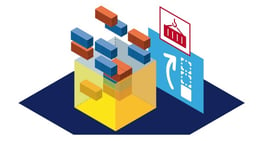How Machine Learning Can Impact Global Logistics
Brian Hoey - June 18, 2019

 As the global scope of the modern supply chain continues to increase, there’s going to be more data available to supply chain planners than ever before. For some businesses, this data will likely just sit there collecting dust—but in point of fact it’s increasingly going to be an important source of value for planners. Why? Because modern analytics processes, powered by technologies like AI and machine learning, are making that data exponentially more valuable as a source of usable insights.
As the global scope of the modern supply chain continues to increase, there’s going to be more data available to supply chain planners than ever before. For some businesses, this data will likely just sit there collecting dust—but in point of fact it’s increasingly going to be an important source of value for planners. Why? Because modern analytics processes, powered by technologies like AI and machine learning, are making that data exponentially more valuable as a source of usable insights.
Of course, the larger introduction of advanced predictive and prescriptive analytics into planning workflows won’t simply affect the inner workings of a few individual companies. On the contrary, as more and more individual businesses adopt analytics workflows of this variety, the entire global logistics chain will begin to undergo significant changes. What kind of changes? We’re glad you asked.
What Defines a Successful Supply Chain?
Let’s back up a step. At this point, some of you might be wondering what, exactly, machine learning is and what analytics powered by this technology might look like. Simply put, machine learning is a method by which algorithms with varying levels of human intervention take in data and uncover patterns that would be difficult or impossible for a human planner to find and analyze. The difficulty of replicating this kind of analysis with human analysts is in part a function of the sheer size of many of the datasets that are being put to use, but also partly the result of the kinds of connections that these algorithms tend to find, i.e. connections that a human wouldn’t necessarily think to look for.
Broadly speaking, analytics flows like these can help to answer the question that has been posed to virtually every type of analytics process, from descriptive and diagnostic to predictive and prescriptive: what are the elements that make for a successful supply chain? On a granular level, individual companies might be looking at elements like the arrangement of their logistics network, down to the placement of hubs, warehouses, distribution centers, etc., or the timelines for securing freight capacity or setting routes, or even the routes themselves. This can help individual businesses to get closer to optimal supply chain functionality in the short-term, but in the long-term it can affect not just the operations of individual businesses, but the ways in which businesses interact with one another.
By way of example, imagine that your company is using machine learning to help determine requirements as you choose a supplier for a particular raw material. You want to be reasonably sure that delays will be kept to a minimum and that you’re getting a fair price. To do this, you start by running simulations that make hypothetical adjustments to your current operations in order to determine what the ideal circumstances for taking on a particular distributor would be. From there, you identify your most suitable contenders, and see what data they can provide in order to help you understand how your two value chains would interact. This process will, naturally, give you a preference for vendors whose IT systems integrate well with your own, yes, but it will also potentially push those with closely-aligned ideas of the ideal supply chain structure into closer collaboration—potentially leading to increased efficiency and synergy.
Reducing Freight Costs Through Analytics
Now, creating alignment between different supply chains is all well and good, but this technology wouldn’t seem as promising as it does were it not for the fact that we can reasonably expect to it lower costs within the logistics chain. Some of the ways in which it’s poised to do this are pretty obvious: by analyzing existing supply chain operations to unearth areas of waste, it’s possible to remedy those wasteful processes and decrease costs; likewise, by uncovering more efficient paths for freight to take not just through the complexity of the global value chain but simply from one place to another, you can decrease fuel costs and time spent in transit.
For an individual business, this ability to identify areas of cost-savings and act on them could yield increased profits and more effective supply chain management. For the global logistics stream as a whole, the effects will be magnified. Increasing numbers of orders managed through increasing numbers of freight providers will be routed through ever-more-optimal paths. Because disruptions downstream in the supply chain can have significant ripple effects, the ability to stave those disruptions off earlier in the process will also have significant ripple effects, leading to more on-time deliveries not just of sourced raw materials but of final products. The end result? Happier customers and happier businesses.
Looking Towards the Future
Of course, we’re still in the relatively early days of this technology, and as such we can only speculate on some of the impacts it will have on global logistics management. For instance, machine learning is an important underlying technology for computer vision, which means that as autonomous vehicles begin to play a larger role in the supply chain this technology’s role will only increase. By the same token, in the future it might give shippers or freight forwarders the ability to predict vehicle breakdowns in advance and take proactive steps to prevent disruptions. Or, it might make it possible to guess with some accuracy whether a particular item has become damaged or otherwise marred during transport.
Whatever happens, you can be fairly well assured that machine learning is going to have wide applications throughout the global value chain, changing the way that goods move from Point A to Point B. As more and more of those theoretical applications become realities, it will be the companies who are already collecting and storing data in an open, visible way that will derive the most benefit. After all, you can’t analyze data that you don’t have—and even once you’ve performed an analysis, the results are only useful insofar as planners can access them as needed. Machine learning can and will pave the way for big changes across the logistics chain, and your business needs to take steps in turn to pave the way for these advanced analytics processes.
LATEST POSTS
- Understand Why Production Planning Needs Specialized Solutions
- Understand Circular Economy in The Manufacturing Industry
- How Can Industry 4.0 IT Integration Be Achieved Smoothly?
- The Significance of Order Sequencing in Discrete Manufacturing
- How to improve your Supply Chain Management: The Power of Control Towers



